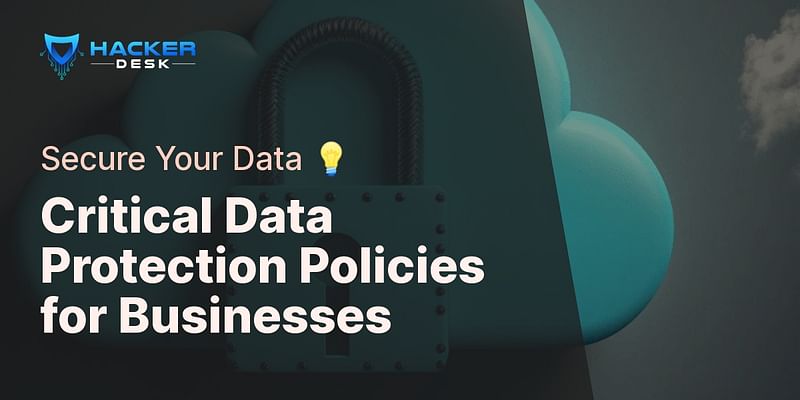Rhett Rowe is a seasoned expert in cybersecurity, boasting over 15 years of professional experience in the industry. He has collaborated with numerous Fortune 500 companies, aiding them in fortifying their digital infrastructures. Rhett is a Certified Ethical Hacker (CEH) and has earned his Master's degree in Information Security from Stanford University.
Hey there! It's great to have you here at HackerDesk, where we're all about keeping you secure in the digital world. Today, I'm going to dive into an important topic for businesses: data protection policies. As cyber threats continue to evolve, it's crucial for businesses to have robust measures in place to safeguard their sensitive information. So, let's explore the key data protection policies that businesses should have in place.
Access Control Methods and Their Features
| Access Control Method | Authentication | Authorization | Data Protection | Ease of Use |
|---|---|---|---|---|
| Passwords | ✅ User-specific credentials | ❌ Limited to single user | ✅ Protects sensitive data | ✅ Easy to use |
| Multi-factor Authentication | ✅ Multiple verification steps | ✅ User and device specific | ✅ High level of data protection | ❌ Can be complex |
| Role-based Access Control (RBAC) | ✅ User and role-specific credentials | ✅ Allows multiple users with same role | ✅ Protects sensitive data by limiting access | ✅ Moderate ease of use |
1. Access Control: Limiting access to sensitive data is a fundamental aspect of data protection. Implementing strong access controls ensures that only authorized individuals can access and modify sensitive information. This can be achieved through user authentication mechanisms like passwords, multi-factor authentication, and role-based access control (RBAC).
2. Data Classification: Businesses should classify their data based on its sensitivity and importance. This allows them to prioritize their security efforts and allocate resources accordingly. Data classification helps in determining the appropriate level of protection required for different types of information.
Types of Data Encryption and Their Importance
| Type of Encryption | Description | Use Case | Benefits |
|---|---|---|---|
| Data at Rest Encryption | Encrypts inactive data stored physically in any digital form (e.g., databases, data warehouses). | Used for protecting sensitive data on business servers and on the cloud. | Prevents unauthorized access, even if the storage medium or backup is stolen or lost. 🔒 |
| Data in Transit Encryption | Encrypts data while it is moving from one place to another (e.g., during an email transmission). | Used for securing data during online transactions, emails, and file transfers. | Protects data from being intercepted or altered during transmission. 📡 |
| Data in Use Encryption | Encrypts data while it is being used or processed (e.g., during a search operation on a database). | Used for securing data during live processing in applications, databases, and services. | Prevents data breaches even when the data is being actively used or processed. 🛡 |
3. Encryption: Encrypting sensitive data is an effective way to protect it from unauthorized access. Encryption converts data into an unreadable format, which can only be decrypted with the right encryption key. Implementing encryption for data at rest, in transit, and in use provides an additional layer of security.
4. Regular Data Backups: Businesses should have a robust backup strategy in place to ensure that their data is protected against loss or corruption. Regularly backing up critical data and testing the restoration process helps in minimizing downtime and recovering from potential data breaches or disasters.
5. Employee Training and Awareness: Employees play a crucial role in maintaining data security. Businesses should provide comprehensive training programs to educate employees about data protection best practices, such as recognizing phishing emails, using strong passwords, and reporting suspicious activities. Regular awareness campaigns can help reinforce these practices.
6. Incident Response Plan: Despite the best preventive measures, data breaches can still occur. Having an incident response plan in place helps businesses respond promptly and effectively to security incidents. This plan should outline the steps to be taken in the event of a breach, including containment, investigation, notification, and recovery.
Security Audits and Penetration Testing Overview
| Audit/Penetration Test Type | Purpose | Frequency | Benefits |
|---|---|---|---|
| Network Security Audit | Identify vulnerabilities in network infrastructure | Quarterly | Prevents unauthorized access 💻 |
| Web Application Penetration Test | Simulate real-world attacks on web applications | Bi-annually | Identifies weak points in web apps 📞 |
| Wireless Network Penetration Test | Assess security of wireless networks | Annually | Prevents Wi-Fi hacking 📴 |
| Mobile Application Penetration Test | Evaluate security of mobile applications | After each major update | Secures mobile apps from breaches 📱 |
| Social Engineering Test | Simulate phishing and other human-factor attacks | Bi-annually | Improves employee awareness 👥 |
7. Regular Security Audits and Penetration Testing: Conducting regular security audits and penetration testing helps identify vulnerabilities and weaknesses in the network infrastructure. These assessments simulate real-world attacks to evaluate the effectiveness of existing security controls and identify areas for improvement.
8. Data Retention and Disposal: Businesses should establish clear policies for data retention and disposal. Storing data for longer than necessary increases the risk of unauthorized access. Properly disposing of data, both physically and digitally, ensures that sensitive information is permanently removed from the organization's systems.
Remember, these are just some of the key data protection policies that businesses should have in place. Each organization's requirements may vary, so it's essential to assess your specific needs and consult with cybersecurity professionals to develop a comprehensive data protection strategy.
Implementing these policies will go a long way in safeguarding your business's sensitive information and maintaining the trust of your customers and partners. If you have any further questions or need assistance with implementing network security measures, feel free to reach out. Stay secure!











